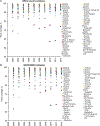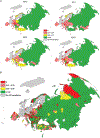Challenges of maintaining polio-free status of the European Region
- PMID: 25316836
- PMCID: PMC10465076
- DOI: 10.1093/infdis/jiu096
Challenges of maintaining polio-free status of the European Region
Abstract
Background: The European region, certified as polio free in 2002, had recent wild poliovirus (WPV) introductions, resulting in a major outbreak in Central Asian countries and Russia in 2010 and in current widespread WPV type 1 circulation in Israel, which endangered the polio-free status of the region.
Methods: We assessed the data on the major determinants of poliovirus transmission risk (population immunity, surveillance, and outbreak preparedness) and reviewed current threats and measures implemented in response to recent WPV introductions.
Results: Despite high regional vaccination coverage and functioning surveillance, several countries in the region are at high or intermediate risk of poliovirus transmission. Coverage remains suboptimal in some countries, subnational geographic areas, and population groups, and surveillance (acute flaccid paralysis, enterovirus, and environmental) needs further strengthening. Supplementary immunization activities, which were instrumental in the rapid interruption of WPV1 circulation in 2010, should be implemented in high-risk countries to close population immunity gaps. National polio outbreak preparedness plans need strengthening. Immunization efforts to interrupt WPV transmission in Israel should continue.
Conclusions: The European region has successfully maintained its polio-free status since 2002, but numerous challenges remain. Staying polio free will require continued coordinated efforts, political commitment and financial support from all countries.
Keywords: European region; polio eradication; polio-free status; poliomyelitis.
Published by Oxford University Press on behalf of the Infectious Diseases Society of America 2014. This work is written by (a) US Government employee(s) and is in the public domain in the US.
Conflict of interest statement
All authors have submitted the ICMJE Form for Disclosure of Potential Conflicts of Interest. Conflicts that the editors consider relevant to the content of the manuscript have been disclosed.
Figures




References
-
- World Health Organization. Certification of Poliomyelitis Eradication. In: Fifteenth Meeting of the European Regional Certification Commission, Copenhagen, 19–21 June 2002. Copenhagen, Denmark: World Health Organization, 2005:1–128.
-
- World Health Assembly Resolution. Completion of polio eradication programmatic emergency for global public health. http://www.polioeradication.org/Resourcelibrary/Declarationsandresolutio.... Accessed 9 December 2013.
-
- Global Polio Eradication Initiative. Polio this week—As of 31 December 2013. http://www.polioeradication.org/Dataandmonitoring/Poliothisweek.aspx. Accessed 3 January 2014.
-
- Centers for Disease Control and Prevention. Outbreaks following wild poliovirus importations — Europe, Asia and Africa, January 2009– September 2010. MMWR Weekly 2010; 59:1393–99. - PubMed
MeSH terms
Grants and funding
LinkOut - more resources
Full Text Sources
Other Literature Sources
Medical

